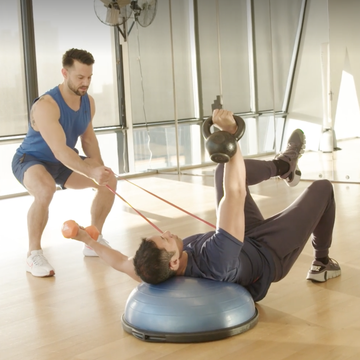MAXING OUT MIGHT have been a fun high school football weight room ritual to show off how much you bench or squat for one, all-out rep, but if you're beyond those glory days and you're still hyper-focused on your one-rep max as your ultimate training goal, it's time to stop. Now.
Unless you’re a competitive powerlifter or weightlifter whose goal is to lift max weight for your sport, dedicating too much of your training focus to one-off max lifts is a bad idea, according to Men’s Health fitness director Ebenezer Samuel, C.S.C.S., and Mathew Forzaglia, N.F.P.T., C.P.T., founder of Forzag Fitness. The experts say maxing out too often is a complete waste of time if your gym goals are to generate muscle and strength gains. There are better means of testing your strength—and for developing it—than just shooting for the highest possible single effort. Even more concerning, if you max out too often, you might wind up limiting your gains and opening yourself up to injury.
“That's why we have three smarter approaches for you that are still gonna let you build strength, still gonna let you push your limits, and in the long term, they just may help your max lifts too,” Samuel says.
Why You Shouldn't Focus Too Much on Maxing Out
You Can Only Max Out on a Few Lifts
Sure, you may at times be tempted to test your max capacity, especially when it comes to the big multi-joint lifts—squat, deadlift, bench press, etc.—but those are special cases. Performing max singles on curls, calf raises, or any other accessory exercise provides no benefit and is just unproductively pointless (and dangerous).
Maxing Out Crushes Your Nervous System
Maxing out a deadlift or squat creates an immense amount of strain and stress on the body—and not just on the muscle groups you think you're targeting. This is especially true on squats and deadlifts, which load the spine, taxing your central nervous system (CNS). This will leave you fatigued, and will oftentimes require an extended amount of recovery afterward. It’s why you'll rarely see powerlifters max out before competition time. Instead, they'll gradually build toward their top lifts over a period of a training cycle. So if you're unnecessarily pushing yourself too much too often, you’re probably pushing your nervous system way too much.
“So one of the issues that happens when people max out and when they do it too frequently is their body is always fatigued,” Samuel says. “That's really going to keep you from actually maxing out to your potential if you were doing it with a more coordinated program. So it's really not good to max out too frequently in your workouts especially to do it multiple times a week.”
Maxing Out Doesn't Promote Hypertrophy
This again comes down to your goals. Chances are, you're not just lifting to be as strong as possible—so muscle growth should be part of your objective, both for aesthetic and health reasons. When your goal is fixed on lifting as heavy as possible, oftentimes you’re exerting your energy at the expense of achieving adequate time under tension, which is what you need in order for growth.
Maxing Out Results in Wear and Tear
Hitting a new PR may provide a short-term ego boost, but over time the strain it required is more likely to lead to joint damage down the road. Most of us will push that weight by any means necessary, which oftentimes is done at the expense of proper form, leading to shoulder strain or knee and lower back issues.
“If you're maxing out too frequently, you're inviting your joints to wind up in bad positions that over time are going to wear down your ligaments and tendons. That is just not a smart way to train,” Samuel says.
3 Better Alternatives to Gauge Your Strength Than Maxing Out
Max Out Reps, Not Weight
If you’ve ever watched the NFL combine, you were more than likely glued to the 225-bench press test where athletes pushed to pump out as many reps as possible. The same principle applies here—but in this case, it's wiser to work with a weight you can push out maybe about three to four reps, then work to build on that number, focusing on safe form. With this approach, you’ll also be spending longer time under tension, which leads to greater muscle and strength gains.
“Now you're maxing out the reps, instead of maxing out the weight. It's gonna be a little bit safer but still like to push your limits,” Samuel says.
Sub-Maximal Lifting
The message here isn’t to stop lifting heavy—continue doing that. However, don’t max out at the expense of establishing optimal time under tension. Here, going a few more reps per set, around three to five, still allows you to lift heavy, but without the extreme wear and tear associated with continuous PR attempts. "We get all the benefits of hypertrophy with the load, time under tension, muscle-mind connection, but now we're in a safer window," Forzaglia says. “So to me being able to move 350 for three to five reps versus one rep at 375 is more impressive.”
Only Max Out Every So Often
All that said, you might still want to max out. If you must, make sure that you only do so when it’s necessary (or desired) to gauge your progress. Try to reduce the amount of times to three or four times per year, at the end of a training cycle. You'll have weeks of training under your belt by that point—and give your joints more time to recover between big time attempts.
“Try those approaches instead of going into the gym every single time and going your heaviest weight for one rep—that's just pointless,” Samuel says. “If you do what we're doing, you're going to gain a lot more muscle a lot more strength and have a bigger max.”













